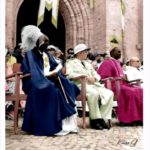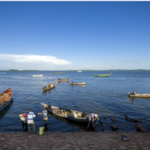Marriage And The Family In Ancient Rwanda
I. Marriage
The family, the social group characterized by common residence, economic co-operation, and reproduction had in Ruanda a conjugal basis that we shall consider in this section.
Married life will not be dealt with here but only the ways and conditions of the establishment of that ‘union between a man and a woman such the children born to the woman are then recognized legitimate offspring of both partners’.
(a) The choice of a spouse
In a primary marriage (the first that an individual contracts) there were few positive socially recognized criteria of choice and none of them indicated one or a few individuals as preferential partners. Among close kin cross-cousins were possible spouses, but it was generally an unfortunate circumstance that obliged a man to marry his cross-cousin. It was usually either because he was not able to pay bride-wealth immediately, or because his cross-cousin had become pregnant by him. We should add that there was no restricted or generalized exchange among the Ruanda in Lévi-Strauss’s sense. On the contrary I was told that because they limited connections, exchanges were not in favour except in some special circumstances (Lévi-Strauss, 1949, PP- 189, 322. There is restricted exchange if, when a man of group A gets a woman frorn group B, it resuIts in a man of group B claiming a woman from group A. Exchange is generalized if when a woman of group A is given to a man of group B, a woman of B must be given to a man of C and a woman of C may be claimed by a man of A).
In the preceding chapter we have mentioned persons whom Ego was prohibited from marrying because of his relations of kinship or affinity with them. Let me sum up the different categories of these persons.
We may start with that which seems fundamental in the sense that in questions of exogamy, informants mention it first and attempt to relate other categories to it: I refer to the primary patrilineage (inzu). People descending in the paternal line from a common ancestor did not intermarry because they were of the same blood. The same principle was logically extended to the secondary patrilineage (umuryango).
A second extension of the taboo concerned the maternal kinship group and had a double basis. First the idea that it would be unnatural and horrible to conceive a marriage between Ego and his mother and consequently between him and any person assimilated to her (her sisters and female parallel cousins). Second, because of the tendency to recognize the cognatic principle, some matrilateral relatives were tabooed because their paternal counterparts were tabooed. This applied to the maternal parallel cousins.
Only when Ego was a male was there a third extension to his in-laws. The explanation given is that it seemed distasteful that a man could have intercourse with a girl and her mother. Consequently the wife’s mother and all the relatives assimilated to the mother were in the prohibited class.
The same taboo included also sororal nieces and grand-nieces of Ego because he had to assume an avuncular attitude towards them, although they belonged to another patrilineage.
A further extension incIuded the spouses of uncles and aunts. The spouse of an aunt was regarded rather as an uncle, and the spouse of an uncle was regarded rather as an aunt.
Ruanda were so eager to form new connections with unrelated kinship groups that they were very keenly aware of any factor favouring them. Some informants stressed the function of exogamy rules from that point of view. Increase of social communication by marriage does not explain all the particular prohibitions, however, since some of them were concerned with people of a different patrilineage. Taboos on marriage and sex relations (they were co-extensive) had, it appears, in some cases the function of keeping a certain cohesion within the large group of relatives by kinship and affinity by preventing rivalry. Prohibition of relations between Ego and his WiBrWi could not favour social communication, but it certainly made possible harmonious relations between Ego and his WiBr.
Inter-caste marriage was not prohibited between Hutu and
Tutsi. Hutu informants say it happened frequently, Tutsi in-formants say the such marriages were very rare, but that Tutsi often had Hutu concubines. This discrepancy shows dearly that for a Tutsi to take a Hutu as wife in a primary marriage entailed a loss of prestige. It was resorted to mainly because of poverty. Bride-wealth was lower in these inter-caste unions (not in the sense that the standard bride-wealth among Hutu was much lower than among Tutsi) and a Hutu girl worked harder than a Tutsi. It does not seem on the other hand that the Hutu girl was particularly proud of having a Tutsi husband. But it is not easy to assess the feelings of a girl in that respect, as no informant seems to have cared very much about them. A prosperous Hutu could marry a Tutsi girl, but then the bride-wealth was often greater than for a Tutsi (three cows instead of one). It happened also that a Tutsi cattle-lord (shebuja) would grant a daughter to one of his Hutu clients. Here again the feeling of the girl was unknown to informants. Such a match could be eagerly sought by a Hutu social climber, but in general Hutu opinion did not look upon it with favour. In a caste society only a few atypical persons are anxious to get as near as they can to the higher stratum. Hutu and Tutsi informants considered any question suggesting inter-marriage with Twa as very insulting.
It was possible to marry a foreign woman, often a war captive who had become a sort of domestic slave. The bride-wealth then had to be paid to her master. Sometimes Ruanda living near the borders married a girl of the neighbouring people (such as Nkole, Rundi) when peaceful relations with that particular people had lasted for some time. There was much reluctance to let a Ruanda girl marry an alien.
Within the borders of Ruanda, local proximity was an important positive factor for Hutu in the choice of a mate. They did not travel very much and as a marriage was primarily a patrilineage affair, they had to know the inzu of the prospective bride or groom and they only knew the groups residing nearby. Tutsi, and particularly those of importance, were less localized than Hutu. They had to go often to the court; they were appointed to administrative charges in one part of the country, then in another one. Consequently interregional marriage was favoured as it usefully extended kinship connections.
What were the qualifications socially considered as the most important for prospective spouses? Among Hutu and Tutsi both patrilineages Iooked for the right connection. Has the man’s (or girl’s) inzu a good reputation? Is it well considered at the king’s court? Are they rich? Is it strategic, in present circumstances, to be allied to them? What are the relations between their cattle-lord and ours? Individual qualifies considered as socially important were for the prospective wife of a Tutsi that she should be expert at keeping a house very clean, at basket work, and at commanding servants. The Hutu wanted a hard-working wife able to help them in the fields. The Twa appreciated, as we may expect, a skilled porter. The most important qualifies of the culturally defined ideal husband was his ability to support economically his wife and their children. That meant for a Tutsi that he should be rich in cattle and clever in political intrigues; for a Hutu that he shouId be a good labourer and a client appreciated by his lord, and for a Twa that he should be a good craftsman or hunter or a buffoon, liked by his Tutsi protectors. These qualifies mentioned by our informants are those which made spouses good partners in the co-operative economic unit of the family. In the mind of Ruanda that aspect of the family was clearly emphasized. Beauty and sex-appeal were also highly appreciated, however, particularly by Tutsi.
The normal marriage age for boys was around twenty-five for Tutsi, seventeen to eighteen, for Hutu, and fifteen for Twa. For girls, when ‘breasts were fully developed and beginning to fall down’ I was told. This gives a rather large range of age. A girl could be married before puberty but she remained with her parents till her first menstruation.
According to informants, virginity was appreciated more than both beauty and ability to co-operate in economic pursuits. This was rationalized in terms of virginity being a guarantee of fertility and of stability in the family. Among the Hutu a small gift was sent to the girl’s parents by the husband when the girl was found to be virgin.
The prospective spouse was not chosen by his or her future partner. The boy could express only to his paternal uncle or aunt nothing more than a wish to get married. The father was told of his son’s desire and then looked for a suitable girl. When she was found, the inzu council met and the advisability of a connection with the girl’s inzu was discussed. When an agreement was reached on the choice, the boy’s father asked for an appointment with the
girl’s father, allowing a sufficient time for the latter to consult his patrilineage. If the answer was favourable, the meeting took place. Accompanied by a kinsman or a client, the boy’s father came to visit the girl’s father and offered him a jug of beer. After some preliminary talk, he came to the point and asked for the girl.
These preliminary steps were taken very skilfully. Nobody should ever be directly refused. If the girl’s kinsfolk did not want the match, the visit of the boy’s father was indefinitely delayed under several pretexts. Nobody should be put in such a position as to lose face. The boy and the girl were never officially consulted during these preparatory stages. If, however, one of them categorically refused the choice made, he was not obliged to marry. But it happened very rarely and the opposition of the individual concerned had to be extremely persistent if it was to succeed.
To marry a certain girl against the consent of one’s own and her parents was impossible. But the following procedure could be attempted. The boy hid himself in a place to which he knew the girl would go. When she was coming he spat in her face a certain herb which had been chewed and mixed with milk (imbazi). They were then considered married as this was the central rite of any wedding. Often the ordinary wedding ceremonies followed. If, however, the girl’s inzu were still opposed to that match, they obliged the girl to whistle and milk a cow. As both these actions -were tabooed for a married woman, it was clearly meant that the girl was not married. The boy’s father had then to pay a fine to the girl’s people as a reparation for the wrong done to the girl’s family.
In secondary marriages (any marriage subsequent to the first one) there were not many more cultural criteria determining the choice of the spouse. Sororal polygyny was permitted but rare. In order to obtain new connections the husband preferred to choose subsequent wives from an inzu other than that of his first wife. Another reason given is that to have two or three sisters as wives brought more domestic troubles than wives who were not con-sanguineal relatives. If, however, his first wife was sterile, the husband was likely to ask for one of her sisters or parallel cousins as a second wife, without paying bride-wealth. But this was not a sororate, for the first wife’s sister was not said to give birth to children for her sister : she was regarded as bearing them for herself. A widow became the wife of one of her late husband’s siblings or agnates designated by the inzu head. Usually an older brother of the husband was chosen. Among the Tutsi this resulted in a levirate: the first husband was still the pater of the children whose genitor was the second husband. Among the Hutu, in similar cases, the genitor was pater. A widower often married a younger sister of his late wife if he was on good terms with his parents-in-law, and if they did not require bride-wealth for the deceased wife’s younger sister. This marriage was favoured because it was thought that it was appropriate that the children of the first wife should be brought up by her sister.
(b) The bride-wealth.
Bride-wealth had to be paid before the wedding ritual, but payment could sometimes be delayed. In that case more jugs of beer had to be given.
There were some regional variations in the amount of the bride-wealth, but within one region it did not vary very much within each caste. Among Tutsi it was usually one cow plus some jugs of beverage, and one hoe. The bride-wealth proper was the cow, as the beverages were rather contributions to the different celebration taking place at the wedding. Among Hutu it was one heifer or cow (which could be replaced by about one dozen pats) and a number of jugs of banana-beer. The following table indicates the average bride-wealth paid by Tutsi and Hutu in the central region of Ruanda. Among Twa bride-wealth was composed of a certain number of pots of beverages.
Table of tee standard marriage gifts and counter gifts in central Ruanda
A. HUTU
Groom’s inzu Bride’s inzu
- One hoe, one jug of beer after agreement
Father…………………………………………………………………………..Father (receives from groom’s father) - One heifer or tweelve to fourteen goats (bride-
wealth) from one to three weeks after r.
(gutebutsa)
Father…………………………………………………………………………. Father (receives from groom’s father) - Household equipment on wedding day (ibirongoranywa)
Groom ………………………………………………………………………. Father (gives to a groom) - One hoe or one sheep or one goat + jugs of beer at the end of seclusion period
Groom………………………………………………………………………… Father (gives to a groom) - One hoe or one sheep or one gooat
(even one heifer) a week after each birth)
Groom………………………………………………………………………..Kinsfolk (gives to groom) - Counter-bride-wealth (stock increase of the bride-wealth)
two or three years after marriage
Father…………………………………………………………………………….Father (gives to groom’s father)
B. TUTSI
One jug of hydromel, one hoe, one isando
(forked branch of ficas tree)
Father………………………………………………………………………Father (receives from groom’s father)
One cow (bride-wealth) (inkwano) a few days later
Father………………………………………………………………………Father (receives from groom’s father)
One cow (counter-bride-wealth) when the bride
leaves her father’s homestead
Father………………………………………………………………………Father (gives to groom’s father)
Household equipment on wedding day (indongoranyo)
Groom………………………………………………………………………..Father (gives to groom)One heifer (izimano) on the day following wedding
Father………………………………………………………………………Male abashyitsi (receives from groom’s father)
One steer (izimano) on the day following wedding
Father………………………………………………………………………Female abashyitsi (receives from groom’s father)
Jugs of beer, pots of milk, sorghum flour (imitwa)
at the end of seclusion period
Groom………………………………………………………………………Father (gives to groom)
One cow, jugs of beer, pots of milk at each birth (ibiheko)
Groom………………………………………………………………………Kinsfolk (receives from Groom)
All our informants agree that bride-wealth was not considered very expensive. Moreover, counter-gifts were about as high. The girl’s father had to provide the young couple with household equipment and to give the husband’s father a counter-bride-wealth approximately equivalent to the bride-wealth itself. Among Tutsi it was proper to give the counter-gift before the wedding. Hutu gave back another heifer not later than after the third calving of the bride-wealth cow. In addition valuable gifts were given by the wife’s kinsfolk after each birth.
Bride-wealth was definitely not a compensation for the economic loss entailed by the girl’s departure from her patrilineage. Her departure was not an impoverishment of her group because it provided it with a new alliance with another descent group ; all informants agree on that. Bride-wealth was the socially recognized symbol of the legitimate transfer of fertility from one descent group to another. As long as bride-wealth had not been given, children borne by the woman were considered as belonging to her inzu (they are called inkuli). The husband was only their genitor, not their pater.
Bride-wealth received by the girl’s father was not to be used only to provide the bride’s brother with a wife. There was no direct relation between a man’s possibility of getting a wife and his sister’s marriage.
Table of tee standard marriage gifts and counter gifts in central Ruanda
A. HUTU
Groom’s inzu Bride’s inzu
- One hoe, one jug of beer after agreement
Father…………………………………………………………………………..Father (receives from groom’s father) - One heifer or tweelve to fourteen goats (bride-
wealth) from one to three weeks after r.
(gutebutsa)
Father…………………………………………………………………………. Father (receives from groom’s father) - Household equipment on wedding day (ibirongoranywa)
Groom ………………………………………………………………………. Father (gives to a groom) - One hoe or one sheep or one goat + jugs of beer at the end of seclusion period
Groom………………………………………………………………………… Father (gives to a groom) - One hoe or one sheep or one gooat
(even one heifer) a week after each birth)
Groom………………………………………………………………………..Kinsfolk (gives to groom) - Counter-bride-wealth (stock increase of the bride-wealth)
two or three years after marriage
Father…………………………………………………………………………….Father (gives to groom’s father)
B. TUTSI
One jug of hydromel, one hoe, one isando
(forked branch of ficas tree)
Father………………………………………………………………………Father (receives from groom’s father)
One cow (bride-wealth) (inkwano) a few days later
Father………………………………………………………………………Father (receives from groom’s father)
One cow (counter-bride-wealth) when the bride
leaves her father’s homestead
Father………………………………………………………………………Father (gives to groom’s father)
Household equipment on wedding day (indongoranyo)
Groom………………………………………………………………………..Father (gives to groom)One heifer (izimano) on the day following wedding
Father………………………………………………………………………Male abashyitsi (receives from groom’s father)
One steer (izimano) on the day following wedding
Father………………………………………………………………………Female abashyitsi (receives from groom’s father)
Jugs of beer, pots of milk, sorghum flour (imitwa)
at the end of seclusion period
Groom………………………………………………………………………Father (gives to groom)
One cow, jugs of beer, pots of milk at each birth (ibiheko)
Groom………………………………………………………………………Kinsfolk (receives from Groom)
All our informants agree that bride-wealth was not considered very expensive. Moreover, counter-gifts were about as high. The girl’s father had to provide the young couple with household equipment and to give the husband’s father a counter-bride-wealth approximately equivalent to the bride-wealth itself. Among Tutsi it was proper to give the counter-gift before the wedding. Hutu gave back another heifer not later than after the third calving of the bride-wealth cow. In addition valuable gifts were given by the wife’s kinsfolk after each birth.
Bride-wealth was definitely not a compensation for the economic loss entailed by the girl’s departure from her patrilineage. Her departure was not an impoverishment of her group because it provided it with a new alliance with another descent group ; all informants agree on that. Bride-wealth was the socially recognized symbol of the legitimate transfer of fertility from one descent group to another. As long as bride-wealth had not been given, children borne by the woman were considered as belonging to her inzu (they are called inkuli). The husband was only their genitor, not their pater.
Bride-wealth received by the girl’s father was not to be used only to provide the bride’s brother with a wife. There was no direct relation between a man’s possibility of getting a wife and his sister’s marriage.
Table of tee standard marriage gifts and counter gifts in central Ruanda
A. HUTU
Groom’s inzu Bride’s inzu
- One hoe, one jug of beer after agreement
Father…………………………………………………………………………..Father (receives from groom’s father) - One heifer or tweelve to fourteen goats (bride-
wealth) from one to three weeks after r.
(gutebutsa)
Father…………………………………………………………………………. Father (receives from groom’s father) - Household equipment on wedding day (ibirongoranywa)
Groom ………………………………………………………………………. Father (gives to a groom) - One hoe or one sheep or one goat + jugs of beer at the end of seclusion period
Groom………………………………………………………………………… Father (gives to a groom) - One hoe or one sheep or one gooat
(even one heifer) a week after each birth)
Groom………………………………………………………………………..Kinsfolk (gives to groom) - Counter-bride-wealth (stock increase of the bride-wealth)
two or three years after marriage
Father…………………………………………………………………………….Father (gives to groom’s father)
B. TUTSI
One jug of hydromel, one hoe, one isando
(forked branch of ficas tree)
Father………………………………………………………………………Father (receives from groom’s father)
One cow (bride-wealth) (inkwano) a few days later
Father………………………………………………………………………Father (receives from groom’s father)
One cow (counter-bride-wealth) when the bride
leaves her father’s homestead
Father………………………………………………………………………Father (gives to groom’s father)
Household equipment on wedding day (indongoranyo)
Groom………………………………………………………………………..Father (gives to groom)One heifer (izimano) on the day following wedding
Father………………………………………………………………………Male abashyitsi (receives from groom’s father)
One steer (izimano) on the day following wedding
Father………………………………………………………………………Female abashyitsi (receives from groom’s father)
Jugs of beer, pots of milk, sorghum flour (imitwa)
at the end of seclusion period
Groom………………………………………………………………………Father (gives to groom)
One cow, jugs of beer, pots of milk at each birth (ibiheko)
Groom………………………………………………………………………Kinsfolk (receives from Groom)
All our informants agree that bride-wealth was not considered very expensive. Moreover, counter-gifts were about as high. The girl’s father had to provide the young couple with household equipment and to give the husband’s father a counter-bride-wealth approximately equivalent to the bride-wealth itself. Among Tutsi it was proper to give the counter-gift before the wedding. Hutu gave back another heifer not later than after the third calving of the bride-wealth cow. In addition valuable gifts were given by the wife’s kinsfolk after each birth.
Bride-wealth was definitely not a compensation for the economic loss entailed by the girl’s departure from her patrilineage. Her departure was not an impoverishment of her group because it provided it with a new alliance with another descent group ; all informants agree on that. Bride-wealth was the socially recognized symbol of the legitimate transfer of fertility from one descent group to another. As long as bride-wealth had not been given, children borne by the woman were considered as belonging to her inzu (they are called inkuli). The husband was only their genitor, not their pater.
Bride-wealth received by the girl’s father was not to be used only to provide the bride’s brother with a wife. There was no direct relation between a man’s possibility of getting a wife and his sister’s marriage.





